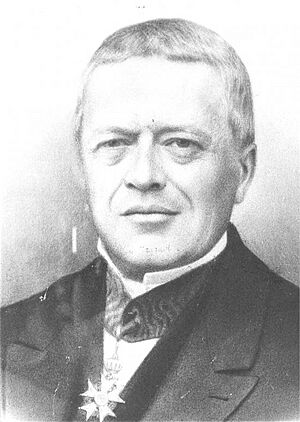Antoine Augustin Cournot facts for kids
Quick facts for kids
Antoine Augustin Cournot
|
|
|---|---|
 |
|
| Born | 28 August 1801 |
| Died | 31 March 1877 (aged 75) |
| Nationality | French |
| Alma mater | Sorbonne University |
| Known for | Cournot competition Oligopoly |
| Scientific career | |
| Fields | Economics Mathematics |
| Institutions | University of Grenoble |
Antoine Augustin Cournot (born August 28, 1801 – died March 31, 1877) was a smart French thinker and math expert. He helped shape the way we understand economics, which is about how money, goods, and services work in the world. He used his math skills to study how markets behave.
Contents
Antoine Cournot's Early Life and Education
Antoine Augustin Cournot was born in a town called Gray, in Haute-Saône, France. In 1821, he got into a very important school called the École Normale Supérieure. This school was for training smart students in many subjects.
In 1823, he earned a math degree from Sorbonne University. After that, he worked as a private secretary for a military leader. This job gave him lots of free time to study on his own.
During these ten years, Cournot earned two more advanced degrees. One was in mechanics, which is about how things move. The other was in astronomy, the study of space. He also wrote many articles and even got a law degree.
Later in his life, Cournot became a math professor. He also worked as a chief examiner for college students. He even became the head of the Dijon Academy. By the time he passed away in 1877, he was almost completely blind.
Cournot's Important Work and Ideas
Cournot was mostly known as a mathematician. However, his ideas also had a big impact on economics. He studied how businesses behave, especially when only a few companies control a market.
How Cournot Changed Economics
Cournot's ideas about monopolies (when one company controls everything) and duopolies (when two companies control everything) are still important today. In 1838, he published a book called Researches on Mathematical Principles of the Theory of Wealth. In this book, he used math formulas and symbols to study economic problems.
At first, people didn't understand his book, and it wasn't very popular. But Cournot tried to rewrite it two more times. Today, many economists believe this book was the start of modern economic analysis. Cournot was one of the first to use ideas like functions and probability in economics.
He also created the first math rule for supply and demand. This rule shows how much of something is available (supply) and how much people want it (demand) based on its price. He was also the first to draw supply and demand curves on a graph. This was about 30 years before another famous economist, Alfred Marshall, did the same thing.
Cournot also developed the Cournot duopoly model. This model helps explain how two companies decide how much to produce when they are competing. It also introduced the idea of a Nash equilibrium. This is a situation where no player can do better by changing their strategy, assuming the other players don't change theirs.
Cournot believed that math should be used in economics to find likely limits. He thought it could help explain facts that are less certain in clearer ways. He also felt that using math in economics didn't always need exact numbers. He is best known in economics for his work on oligopoly theory, which is about markets with a few big companies. The idea of Cournot competition is named after him.
Cournot's Thoughts on Philosophy
Cournot also thought a lot about philosophy. He studied ideas like determinism and chance. Determinism is the idea that everything is already decided. Chance is the idea that things happen randomly.
Some thinkers, like Pierre-Simon de Laplace, believed nothing happens by chance. Others, like Aristotle, thought randomness and cause-and-effect were completely separate. Cournot had a different idea. He said that randomness happens when two separate chains of events meet by accident.
For example, imagine you are walking down the street (one chain of events). At the same time, a flower pot falls from a window (another chain of events). If you happen to be in the exact spot where the pot falls, that's a random event. This is because your walk and the pot falling were two independent things that just happened to cross paths. This idea is even used today to create random numbers by combining unrelated signals, like temperature and sound.
See also
- Hotelling's linear city model

